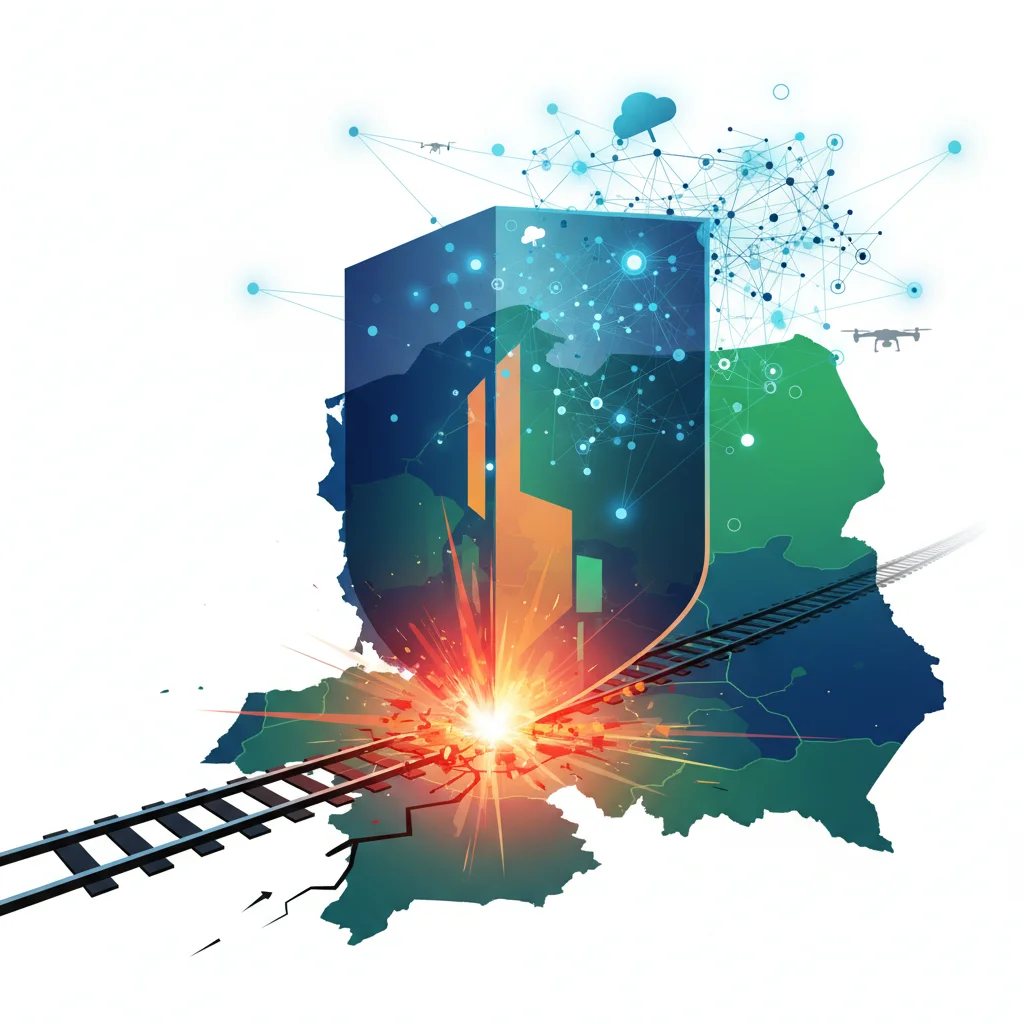
The New Iron Curtain: How AI and Cloud Software are Building Poland’s Drone Shield
It started with a jarring explosion on a railway line in Poland, a critical artery for supplies heading to Ukraine. Warsaw was quick to point the finger, blaming Moscow for an act of sabotage. This single event, while alarming, is a symptom of a much larger shift in modern conflict. The battlefield is no longer confined to trenches and tank columns; it has expanded into the digital and autonomous realms. In response, Poland is accelerating plans for a national “drone shield,” a project that signals a profound pivot in how nations must think about defense. This isn’t just about military hardware; it’s a monumental undertaking in software, artificial intelligence, and national-scale cybersecurity.
For developers, tech entrepreneurs, and innovators, this story is more than a geopolitical headline. It’s a real-world case study on the convergence of technology and national security, highlighting a burgeoning market where cutting-edge AI, distributed cloud systems, and rapid automation are no longer optional—they are essential for survival. Let’s deconstruct what a “drone shield” actually is and explore the immense technological challenges and opportunities it represents.
The Democratization of Air Power: Why Everyone Needs a Shield
The war in Ukraine has been a brutal, live-fire demonstration of 21st-century warfare. One of its most defining features is the ubiquity of unmanned aerial vehicles (UAVs), or drones. Off-the-shelf consumer drones, modified with small explosives, have become potent weapons, while sophisticated military-grade drones conduct reconnaissance and precision strikes. This has effectively democratized air power. For a few thousand dollars, non-state actors or clandestine operatives can now deploy a threat that once required an air force.
This is the new reality that Poland, and every other nation on NATO’s eastern flank, is facing. Critical infrastructure—power grids, communication hubs, pipelines, and as we’ve seen, railways—is suddenly vulnerable to cheap, hard-to-detect aerial threats. A physical fence is useless against a threat from above. The solution must be technological, a digital dome of protection that can see, think, and act at machine speed.
This is where the concept of a national drone shield moves from science fiction to strategic necessity. It’s an integrated, multi-layered defense system designed to detect, track, identify, and neutralize hostile drones across an entire country. Building it is less like manufacturing a tank and more like developing a massive, distributed SaaS platform for national defense.
Beyond the AI Hype: Why "Boring" Stocks Are Suddenly a Hot Topic in Tech
Anatomy of a Digital Shield: The Tech Stack of Modern Defense
A national drone shield isn’t a single piece of hardware. It’s a complex ecosystem of sensors, effectors, and intelligent software working in perfect concert. Think of it as a national-scale Internet of Things (IoT) network, but instead of smart toasters, it’s tracking objects moving at 100 mph with malicious intent.
1. The “See” Layer: Detection and Identification
You can’t stop what you can’t see. The foundation of the shield is a network of diverse sensors, each with its own strengths and weaknesses. The real magic happens when data from all these sources is fused together using sophisticated machine learning algorithms.
- Radar: The classic solution, but small, low-flying drones made of plastic are notoriously difficult for conventional radar to pick up. Advanced micro-Doppler radar systems are needed to detect the unique signature of a drone’s rotating blades.
- Radio Frequency (RF) Scanners: Most drones communicate with a ground controller via radio signals. RF sensors can “listen” for these specific frequencies, detecting and sometimes even identifying the drone model. This is a crucial area for cybersecurity experts.
- Acoustic Sensors: Arrays of sensitive microphones can listen for the distinctive high-pitched whine of drone propellers. In quiet environments, this can be an effective and low-cost detection method.
- Electro-Optical/Infrared (EO/IR): High-resolution cameras, both in the visible and thermal spectrums, act as the system’s eyes. This is where AI plays a starring role. Machine learning models must be trained to differentiate a drone from a bird, a plastic bag, or other clutter with near-perfect accuracy to avoid false alarms. This is a classic computer vision problem, but with life-or-death stakes.
2. The “Think” Layer: Command and Control (C2)
This is the brain of the operation. All the raw data from the sensor network streams into a central C2 system. This is not a single server in a bunker; it’s a resilient, distributed cloud architecture. The C2 software is responsible for:
- Data Fusion: Combining data from RF, radar, and optical sensors to create a single, unified operating picture. An AI algorithm might correlate a faint radar blip with a specific RF signal to confirm a threat.
- Threat Classification: Is it a DJI Mavic 3 or a military-grade Shahed? Is it on a reconnaissance path or a direct attack vector? Machine learning models, trained on vast datasets of drone flight patterns and characteristics, make these calls in milliseconds.
- Decision Support: The system must present clear, actionable intelligence to a human operator, recommending the best course of action. This involves complex programming and a deep understanding of user interface design under pressure.
- Automation: For fast-moving swarms, human reaction time is too slow. The system needs a high degree of automation to track multiple targets and, in some scenarios, engage them autonomously based on pre-defined rules of engagement.
3. The “Act” Layer: Interdiction and Neutralization
Once a threat is confirmed, the shield needs a way to neutralize it. This involves a range of “effectors,” and the choice depends on the location and nature of the threat (you don’t fire a missile at a drone over a crowded city).
Below is a comparison of common anti-drone technologies, showcasing the trade-offs that system architects and policymakers must consider.
| Technology Type | Method | Pros | Cons |
|---|---|---|---|
| Electronic Warfare (EW) | Jamming RF signals to sever the drone’s link to its controller or GPS. | Non-kinetic (no explosions), effective against swarms, low collateral damage. | Can disrupt civilian communications (Wi-Fi, GPS); some drones have autonomous “return-to-home” or pre-programmed routes. |
| Kinetic Solutions | Physically disabling the drone with nets, projectiles, or another “hunter-killer” drone. | Confirms physical destruction of the threat. | High risk of collateral damage from falling debris or missed shots; difficult to use in urban areas. |
| Directed Energy | High-power microwaves (HPM) to fry electronics or high-energy lasers to melt the drone’s chassis. | Instantaneous, precise, low cost per “shot,” minimal debris. | Requires line-of-sight, effectiveness reduced by weather (fog, rain), significant power requirements. |
| Cyber/Protocol Takeover | Exploiting vulnerabilities in the drone’s communication protocol to take control. | Allows for safe landing and forensic analysis of the drone. | Highly complex, requires specific exploits for each drone type, a constant cybersecurity cat-and-mouse game. |
Beyond the Hype: Deconstructing OpenAI's High-Stakes Deal-Making Strategy
A New Frontier for Tech Startups and Innovation
While giant defense corporations will undoubtedly play a role, a project of this scale and complexity is ripe for disruption by agile tech companies and startups. A monolithic, waterfall-development approach is too slow and rigid for a threat that evolves daily. The Polish government, and others who will follow, will need to embrace a more modular, API-driven architecture.
This creates incredible opportunities for companies specializing in:
- AI and Machine Learning: Startups with novel algorithms for object detection in cluttered environments, sensor fusion, or predictive flight path analysis could become critical suppliers. This is a high-stakes application of the same AI tech used in self-driving cars.
- Cloud-Native Software: The C2 platform requires expertise in building scalable, resilient, and secure distributed systems. Companies with experience in microservices, Kubernetes, and edge computing have a massive advantage. The programming challenge is immense.
- Cybersecurity: The drone shield is both a cybersecurity defense and a high-value target for cyberattacks. Experts in RF communications, protocol analysis, and hardening critical infrastructure will be in high demand. As state-backed sabotage becomes more common, securing these defense systems is paramount.
- Specialized Hardware: Innovation in low-cost, high-performance sensors (like solid-state LiDAR or advanced acoustic arrays) is a key enabler.
For entrepreneurs, the lesson is clear: some of the biggest challenges in national security are, at their core, problems of data, software, and automation. The solutions will come from the same talent pool that is currently building the next generation of enterprise SaaS or consumer tech. The “dual-use” potential means that a technology developed for a civilian purpose could become a cornerstone of national defense, and vice-versa.
The Glass Box Revolution: Why Transparent AI is the Key to Rebuilding Our Trust in Technology
The Dawn of the Algorithmic Battlefield
Poland’s plan to build a national drone shield is a direct consequence of a paradigm shift in warfare. The alleged Russian sabotage is just the latest catalyst pushing nations to confront a future where the front line is everywhere. The response they are crafting is a testament to how deeply intertwined technology and security have become.
This isn’t just about Poland. This is a blueprint. We are witnessing the dawn of the algorithmic battlefield, where victory is determined not just by firepower, but by the speed and intelligence of your code. The shields of the future won’t be forged from steel, but from silicon, intelligent software, and the relentless pursuit of technological innovation. For the tech community, this is a call to action. The skills honed in building scalable cloud platforms, pioneering AI models, and securing digital networks are now on the front line of national defense.

